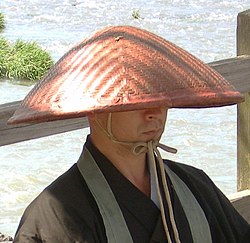Hello, you have come here looking for the meaning of the word . In DICTIOUS you will not only get to know all the dictionary meanings for the word , but we will also tell you about its etymology, its characteristics and you will know how to say in singular and plural. Everything you need to know about the word you have here. The definition of the word will help you to be more precise and correct when speaking or writing your texts. Knowing the definition of, as well as those of other words, enriches your vocabulary and provides you with more and better linguistic resources.

笠
| ||||||||
| ||||||||
Translingual
Han character
笠 (Kangxi radical 118, 竹+5, 11 strokes, cangjie input 竹卜廿 (HYT), four-corner 88108, composition ⿱𥫗立)
Derived characters
References
- Kangxi Dictionary: page 880, character 7
- Dai Kanwa Jiten: character 25924
- Dae Jaweon: page 1308, character 3
- Hanyu Da Zidian (first edition): volume 5, page 2959, character 2
- Unihan data for U+7B20
Chinese
| trad. | 笠 | |
|---|---|---|
| simp. # | 笠 | |
Glyph origin
| Historical forms of the character 笠 | |
|---|---|
| Shuowen Jiezi (compiled in Han) | Liushutong (compiled in Ming) |
| Small seal script | Transcribed ancient scripts |

|

|
Phono-semantic compound (形聲 / 形声, OC *ɡ·rɯb): semantic 竹 (“bamboo”) + phonetic 立 (OC *rɯb).
Etymology 1
Compare Proto-Tai *klɤpᴰ (“bamboo hat”) (Schuessler, 2007).
Pronunciation
- Mandarin
- Cantonese
- Gan (Wiktionary): lit6
- Hakka
- Jin (Wiktionary): lieh4
- Northern Min (KCR): sā̤ / lĭ
- Eastern Min (BUC): lĭk
- Southern Min
- Wu (Shanghai, Wugniu): 8liq
- Xiang (Changsha, Wiktionary): li4
- Mandarin
- (Standard Chinese)+
- Hanyu Pinyin: lì
- Zhuyin: ㄌㄧˋ
- Tongyong Pinyin: lì
- Wade–Giles: li4
- Yale: lì
- Gwoyeu Romatzyh: lih
- Palladius: ли (li)
- Sinological IPA (key): /li⁵¹/
- (Chengdu)
- Sichuanese Pinyin: ni2
- Scuanxua Ladinxua Xin Wenz: li
- Sinological IPA (key): /ni²¹/
- (Standard Chinese)+
- Cantonese
- (Standard Cantonese, Guangzhou–Hong Kong)
- Jyutping: lap1 / lap6
- Yale: lāp / lahp
- Cantonese Pinyin: lap7 / lap9
- Guangdong Romanization: leb1 / leb6
- Sinological IPA (key): /lɐp̚⁵/, /lɐp̚²/
- (Taishanese, Taicheng)
- Wiktionary: lap2
- Sinological IPA (key): /lap̚⁵⁵/
- (Standard Cantonese, Guangzhou–Hong Kong)
- Gan
- (Nanchang)
- Wiktionary: lit6
- Sinological IPA (key): /lit̚⁵/
- (Nanchang)
- Hakka
- (Sixian, incl. Miaoli and Neipu)
- Pha̍k-fa-sṳ: lip
- Hakka Romanization System: libˋ
- Hagfa Pinyim: lib5
- Sinological IPA: /lip̚²/
- (Meixian)
- (Sixian, incl. Miaoli and Neipu)
- Jin
- (Taiyuan)+
- Wiktionary: lieh4
- Sinological IPA (old-style): /liəʔ²/
- (Taiyuan)+
- Northern Min
- (Jian'ou)
- Kienning Colloquial Romanized: sā̤ / lĭ
- Sinological IPA (key): /sɛ⁵⁵/, /li²⁴/
- (Jian'ou)
Note:
- sā̤ - vernacular;
- lĭ - literary.
- Eastern Min
- (Fuzhou)
- Bàng-uâ-cê: lĭk
- Sinological IPA (key): /l̃iʔ⁵/
- (Fuzhou)
- Southern Min
Note:
- loe̍h/le̍h/lēre - vernacular;
- li̍p - literary.
- Middle Chinese: lip
- Old Chinese
- (Baxter–Sagart): /*k.rəp/
- (Zhengzhang): /*ɡ·rɯb/
Definitions
笠
Synonyms
Dialectal synonyms of 斗笠 (“Asian conical hat”)
Compounds
Etymology 2
Pronunciation
- Cantonese
- (Standard Cantonese, Guangzhou–Hong Kong)
- Jyutping: lap1
- Yale: lāp
- Cantonese Pinyin: lap7
- Guangdong Romanization: leb1
- Sinological IPA (key): /lɐp̚⁵/
- (Standard Cantonese, Guangzhou–Hong Kong)
Definitions
笠
- (Cantonese, Nanning Pinghua, Leizhou Min) basket (made from interwoven bamboo strips)
- (Cantonese, Leizhou Min) to cover (with); to slip on
- (Cantonese) to flatter; to fool
Compounds
Japanese

Kanji
笠
Readings
Etymology
| Kanji in this term |
|---|
| 笠 |
| かさ Jinmeiyō |
| kun'yomi |
From Old Japanese, from Proto-Japonic *kasa (“cover, hat”). Cognate with Miyako 笠 (kasa), Okinawan 笠 (kasa), Yaeyama 笠 (kasa). Related to 傘 (kasa, “umbrella”).
Pronunciation
Noun
References
- ↑ 1.0 1.1 “かさ 【笠・傘・暈】
 ”, in 日本国語大辞典 (in Japanese), 2nd edition, Tokyo: Shogakukan, 2000-2002, released online 2007, →ISBN, concise edition entry available here
”, in 日本国語大辞典 (in Japanese), 2nd edition, Tokyo: Shogakukan, 2000-2002, released online 2007, →ISBN, concise edition entry available here
- ^ Hirayama, Teruo, editor (1960), 全国アクセント辞典 (Zenkoku Akusento Jiten, “Nationwide Accent Dictionary”) (in Japanese), Tōkyō: Tōkyōdō, →ISBN
Korean
Hanja
笠 (eumhun 삿갓 립 (satgat rip), word-initial (South Korea) 삿갓 입 (satgat ip))
- This term needs a translation to English. Please help out and add a translation, then remove the text
{{rfdef}}.
Vietnamese
Han character
笠: Hán Nôm readings: lạp, lợp, lép, liếp, lụp, rạp, lẹp, lớp, nập, rập, sập, sệp, sụp, tấp
- This term needs a translation to English. Please help out and add a translation, then remove the text
{{rfdef}}.
